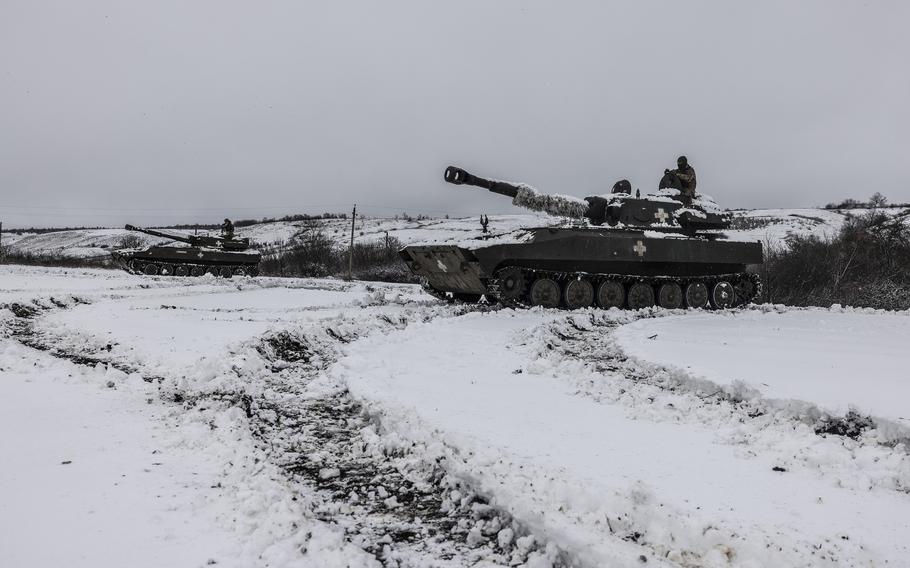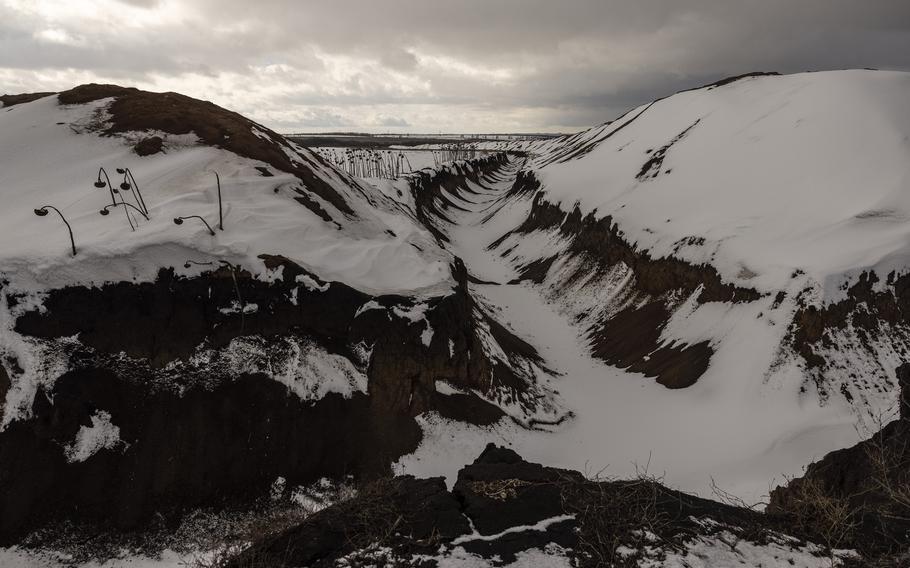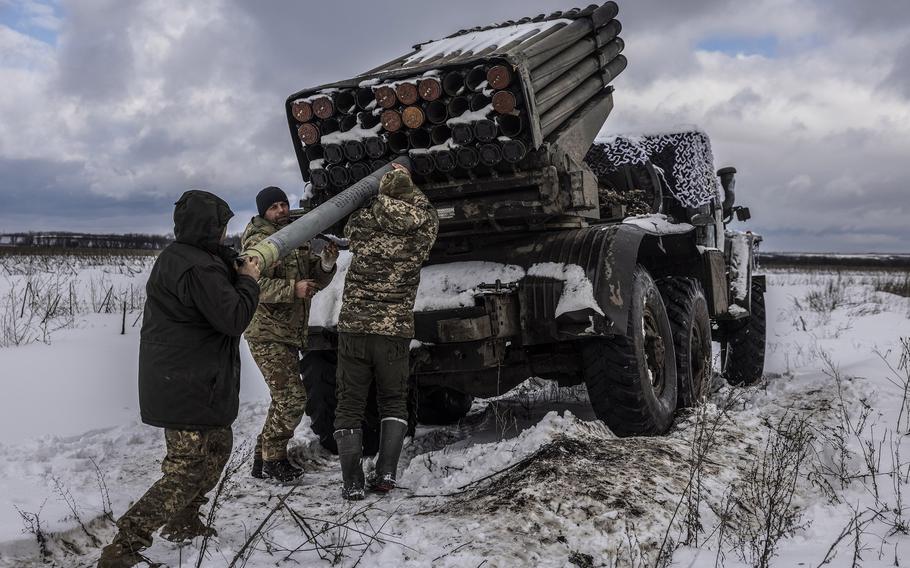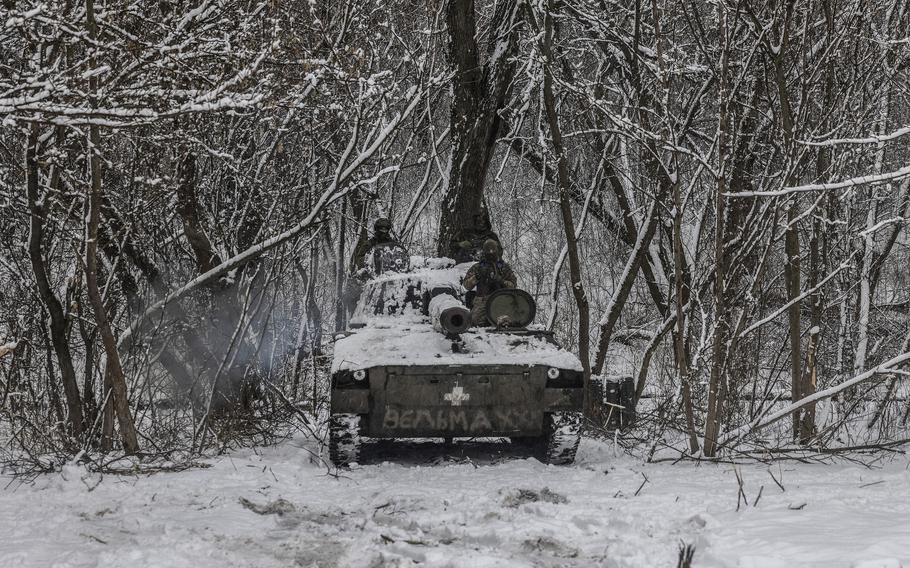Europe
As Russians inch forward near Bakhmut, Ukrainians dig fallback defenses
The Washington Post February 16, 2023

Ukrainian 2S1 Gvozdika howitzers move forward in Donetsk on Feb. 14, 2023. (Heidi Levine/for The Washington Post)
DONETSK REGION, Ukraine — The closest Ukrainian artillery position to the raging battle for Bakhmut is tucked into a leafless tree line about 13,000 feet from the enemy.
The fighters here have been hanging on for weeks, lobbing 122mm shells at the Russians straining to encircle the city. If the Russians push even a bit closer, the Ukrainians will have to move their guns back simply to keep from firing over the enemy's heads, the platoon leader said Tuesday.
"If they get any closer our guns are not effective," said the leader, Oleksander, as a crossfire of Ukrainian howitzers and Russian rockets whistled overhead. His own mobile artillery piece boomed into the snowfall, shaking flakes onto the log-covered bunker where his troops have been living since December, as smoke drifted from the spent shell they use as a chimney.
"Today we are still holding them, but it is very dynamic," said Oleksander, an officer in the 128th Mountain Assault Brigade whom The Washington Post is identifying only by his first name to protect his safety. "It can change in a day."
But even if the Russians move forward, they will not get far, he said. Combat earthmovers were digging new trench lines on a ridge just a few hundred yards farther west.
All around this front line in flux, Ukrainians are preparing for the possibility that Russia will continue its creeping advance. This is a war of feet, not miles — and nowhere is that more apparent than in the wintry countryside outside Bakhmut, which has become the epicenter of Russia's push to regain momentum in its year-old invasion.

A Ukrainian military trench in Donetsk. (Heidi Levine/for The Washington Post)
Any Ukrainian fallback is likely to be limited, commanders in the region say. Even if Ukrainian troops give up on their ferocious defense of Bakhmut — a fight that has assumed more symbolic than strategic value, according to military experts — Russia lacks the trained troops and weaponry to rush headlong into the wider Donetsk region.
Rather, the Russians are likely to nudge the Ukrainians back to entrenched positions they are readying around nearby communities, including Chasiv Yar, Kramatorsk and Kostiantynivka, where the slugfest for territory will continue.
It has happened before. Russian forces last summer took the nearby city of Lysychansk, just over the border in the Luhansk region, after battering it for weeks, and got as far as Lyman 36 miles west, in Donetsk. But they lost Lyman in Ukraine's counteroffensive last fall. Bakhmut, the next major target in Moscow's plan to conquer all of southeastern Ukraine, is 37 miles west of Lysychansk and still not firmly in Russia's grip after months of fighting.
The soldiers here expect the same grinding dynamic to continue, with Russia throwing mostly untrained conscripts at the new Ukrainian defensive positions as they have in the bloody streets of Bakhmut.
"They send in 20 people at a time and we stop them," said Rostyslav, the commander of two artillery positions in the area. "Then the more professional Wagner troops follow," he said, referring to the mercenaries that have led many of the attacks.
Behind him, two of his Soviet-era 2S1 Gvozdika guns (the name means "carnation") trundled along a ridge, always in pairs in case one breaks down and needs a tow from the other. The guns were born long before most of the men who operate them — "20 years before," said Rostyslav, who is 24.
The 128th were brought in from Zaporizhzhia in December to help plug the line in Bakhmut because their 70 percent accuracy rate ranks them as some of deadliest artillery fighters in Ukraine.
The units are training their fire on the lines around Bakhmut and the key M03 highway that is a major route in the area. The 128th would provide cover for any fallbacks along the road, an eventuality the fighters do not like to talk about. They have begun to conserve their shells as they wait for new ammunition deliveries.
"They sent us because we are the best," said a sergeant known by his radio call sign of "Al-Kut." "We can hold them, but we need ammunition and weapons."
The fight for Bakhmut has become a Ukrainian rallying cry and a Russian imperative as each side girds for expected major offensives to kick off the second year of war.
Moscow is desperate for a symbolic victory to reverse months of humiliating defeats during Ukrainian counteroffensives in Kharkiv and Kherson. After battering Bakhmut frontally for months, Russian troops have picked off small villages to the north in an attempt to surround the city.
Wagner fighters took the nearby salt mining town of Soledar in January, causing the 128th "to make a small shift to the side," Rostyslav acknowledged.
Ukrainians, meanwhile, are hailing their fighters' scrappy defense of Bakhmut as another modern Thermopylae, akin to the holdouts who refused to give up the Azovstal steel plant in Mariupol for weeks before the Russians took the city in May.
The latest fight has inspired memes, a cheer ("Bakhmut holds!") and a viral pop anthem ("Bakhmut fortress; all our prayers are here.") President Volodymyr Zelenskyy, who made a surprise visit in December, has pledged Bahkmut will stand.
Fervor notwithstanding, soldiers and civilians up and down the line are ready for the front to shift again.

Ukrainian forces load a Grad rocket launcher in Donetsk on Feb. 14, 2023. (Heidi Levine/for The Washington Post)
At a field hospital west of the city, doctors said they have already prepared their contingency plans for moving, even as they deal with a surge in causalities from the fighting in Bakhmut.
"His leg is torn off," an orderly shouted as soldiers banged a gurney through the front door of what used to be a village clinic.
"In here," said a doctor, Oleg Tokarchyk, backing into the small surgical suite.
As the team of doctors and nurses rushed to stabilize the massive shrapnel wound that had splintered the femur and destroyed most of the flesh, another wounded soldier was being treated for shoulder wounds.
"We were just pulling out when they hit us," said the fighter, Oleksi, 40, of an artillery strike just outside of Bakhmut.
He tapped out a text to his parents: "Everything is good here. It was snowing, but it stopped."
Many of those posted in this hottest of hot zones lie to their families. Tokarchyk, a pediatric orthopedist in civilian life, tells his wife he is working at a hospital far from the front.
"If it gets any more dangerous here, we will have to move out," he said.
They have already identified a location a bit farther back, one with good road access. It will take two or three days to set up the new site.

Ukrainian forces tucked within a snowy forest on a 2S1 Gvozdika Soviet-era howitzer in the Donetsk region of eastern Ukraine on Feb 14, 2023. (Heidi Levine/for The Washington Post)
Along the same road, some of the big commercial farm operations are making their own moves. Siversk Agro packed up its grain processing equipment on Sunday, according to a lone worker who was guarding the now empty warehouse.
And closer to the advancing front, four massive harvesting combines pulled slowly away from the machinery yard of Bakhmut Agro as the sound of shelling rumbled up the rolling hillsides. An unexploded rocket was embedded amid the stalks of a spent sunflower field nearby.
The company, which farms more than 14,000 acres of corn, wheat and sunflowers, would not comment on what made it leave the area now, or its plans for the future. "We have been getting the equipment out but our business is the land," said an employee who would not give her name.
Marko Fedak, a priest who has endured the windows of his church being blown out and the evacuation of all but five of his regular churchgoers from his village of Zvanivka, is finally making his own escape, at least for now.
"I hope to be back to give an Easter mass here," said Fedak, who was picking up pieces of wood that had been the Tenth Station of the Cross before it was blasted by a shell the day before. "If it is still not safe here, I have already prepared my paperwork to become an Army chaplain," he said.
Residents here know the front is fluid. Gains by either side may not last. For months, Fedak was blocked by Russians from driving north, but that route opened after Ukraine retook some areas in October.
Kostiantynivka, one of the cities coming under greater shelling as the Russians inch westward, lost one of its three water supply lines when Russia took territory near Bila Hora. But it regained one coming from the north after the Ukrainian army liberated areas above Sloviansk.
This ebb and flow makes it a tough call for citizens who are cowering under the current pitch of shelling, but hope for things to improve. "They are worried what the Russians would do to them but also afraid to leave their homes behind," Fedak said of one family in his parish.
Now may be the time to decide. The Russians are less than a mile from their house, he said, and slowly getting closer.